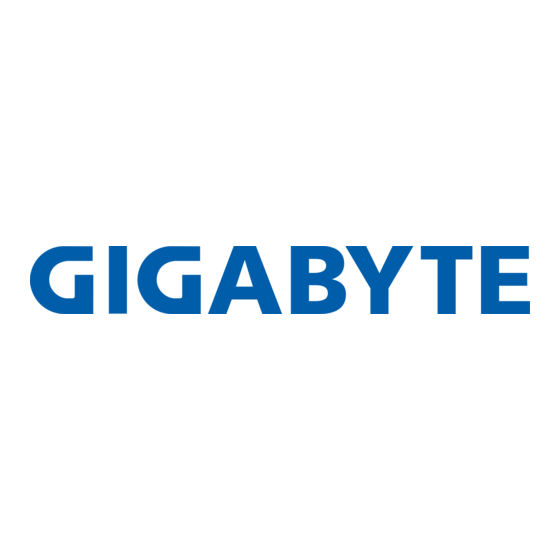
Subscribe to Our Youtube Channel
Summary of Contents for Gigabyte GN-WLBZ101
- Page 1 GN-WLBZ101 IEEE 802.11b USB STICK Wireless LAN Card User’s Manual http://www.gigabyte.com.tw Rev. 1.0 First Edition...
-
Page 2: Important Note
Federal Communication Commission Interference Statement This equipment has been tested and found to comply with the limits for a Class B digital device, pursuant to Part 15 of the FCC Rules. These limits are designed to provide reasonable protection against harmful interference in a residential installation. This equipment generates, uses and can radiate radio frequency energy and, if not installed and used in accordance with the instructions, may cause harmful interference to radio communications. -
Page 3: Table Of Contents
CHAPTER 1. PRODUCT OVERVIEW 1-1. I NTRODUCTION TO 1-2. F ...1 EATURES 1-3. P HYSICAL IMENSIONS 1-4. LED I NDICATING 1-5. S YSTEM EQUIREMENTS CHAPTER 2. INSTALLING THE WIRELESS LAN CARD 3 2-1. I NSTALLING RIVER CHAPTER 3. USING THE UTILITY ON PC 3-1. -
Page 4: Chapter 1. Product Overview
1-3. Physical Dimensions/Packaging Dimensions: 109mm* 25mm* 16mm Before the installation procedures, please ensure the components are not damaged during the shipping. The shipment of the GN-WLBZ101 includes: One GN-WLBZ101 Wireless LAN Card One Installation CD (including User’s Guide and Driver) -
Page 5: System Requirements
Power: This LED is continuously on while the card is powered on. Link: Blinking Slow Continuously On Blinking Quickly LED Light Condition of the Receiver Intensity of received signals: This LED specifies the four conditions of “POOR”, “FAIR”, “GOOD”, and “EXCELLENT” . LED Light Condition of the Receiver... -
Page 6: Chapter 2. Installing The Wireless Lan Card
Step 2: Execute the setup.exe on our CD, and then the following window will pop up. Click “Install Wireless LAN Driver”. Step 3: Click “Yes”. Step 4: Please plug-in your “Gigabyte WLAN card device” ! and will install the device driver Click “Yes”, and then your installation is ok. -
Page 8: Chapter 3. Using The Utility On Pc
Chapter 3. Using The Utility on PC The Configuration & Monitor Utility is a powerful application that helps you to configure the card and monitor the statistics of the communication link. Unlike the standard method of configuring the card via the operating system utilities (e.g. Control Panel), this application permits the dynamic modification of the configuration parameters while the card is operating. -
Page 9: Statistics
SSID: Network name. Channel: The current channel used by the wireless LAN card. Tx Rate: The current transmission rate used by the wireless LAN card. AP Signal: It shows the signal quality and signal intensity of the currently connected base station. - Page 10 The Configuration Tab contains several fields where operating parameters of the driver can be viewed or changed. Changes to any of the parameters in this panel can be applied to the driver without resetting the wireless LAN card(see Figure 3-4). Figure 3-4.
-
Page 11: Encryption
3-4. Encryption To prevent unauthorized user to access the data on wireless stations, the Wireless LAN Card offers a highly secure data encryption, known as WEP (Wired Equivalent Privacy). If you require high security in transmission, go to the Encryption tab and set it up as follows(see Figure 3-5). -
Page 12: About
configuration settings, such as the Fragmentation Threshold, and RTS/CTS Threshold (see Figure 3-6). Figure 3-6 shows the default configuration for the advanced settings. Note: In order to enable the Fragmentation and the RTS/CTS Threshold parameters move the slide bar with your mouse and then use the right and left arrow keys of your keyboard in order to select an exact number. - Page 13 Figure 3-8. Current link states of the Access Point Mode Access Point: The AP mode You can change WLAN mode(see 3-1 Info) by clicking on this button. More Setting: You can set the configuration Access Point(see Figure 3-9) by clicking on this button.
-
Page 14: Bridge Setup
SSID: Network name. Hide SSID: Access Point disable their SSID broadcasting to prevent a wireless device from finding and accessing their networks. Tx Power: Transmitter Output power. MAC Address Filter: You can set the configuration MAC Address Filter(see Figure 3-10) by clicking on this button. - Page 15 Figure 3-11. Control Panel Step 3: Setup Wireless LAN card(see Figure 3-12), Click ”Use Windows to configure” to cancel the schedule and Click「OK」. Figure 3-12. Wireless Networks Step 4 : Select the network connections to be bridged. Press the 「Ctrl」 key while clicking the network connection icons to select.
-
Page 16: Ip Sharing
Figure 3-13. Bridge Connections Figure 3-14. Network Bridge Step 5: Setup OK,Show Network Bridge windows(see Figure 3-15) and then your setup is ok. Figure 3-15. Network Bridge Enabled 3-9. IP Sharing (Supported under Windows 2000) Step 1: Change to AP mode (see Figure 3-8). Step 2: 「Control Panel」run「Network and Dial-up Connections」... - Page 17 Figure 3-16. Control Panel Step 3: Setup LAN card(see Figure 3-17), Click ”Enable Internet Connection Sharing for this connection” and Click「OK」. Figure 3-17. Local Area Connection Properties Step 4: Show Local Network(see Figure 3-18). Click「OK」 and then your setup is ok. Figure 3-18.
-
Page 18: Chapter 4. Specification
Antenna one built-in Chip antennas Regulatory and Environmental Compliance FCC part 15 (USA) EMC certification CE (Europe) Temperature Range Operating: 0 ~ 50 degree C, Storage: -20 ~ 65 degree C Humidity Max. 90% Non-condensing Software Driver Windows 98SE/ME/2000/XP Roaming...



Need help?
Do you have a question about the GN-WLBZ101 and is the answer not in the manual?
Questions and answers